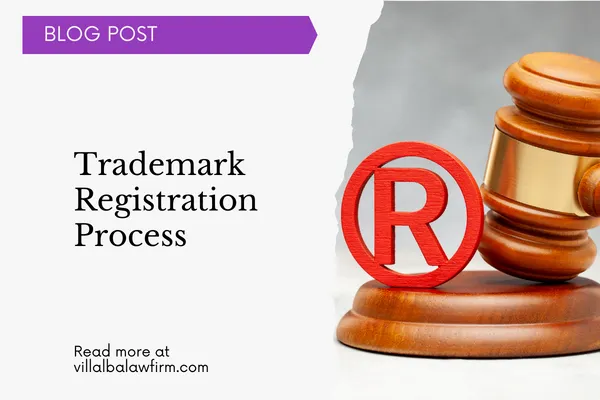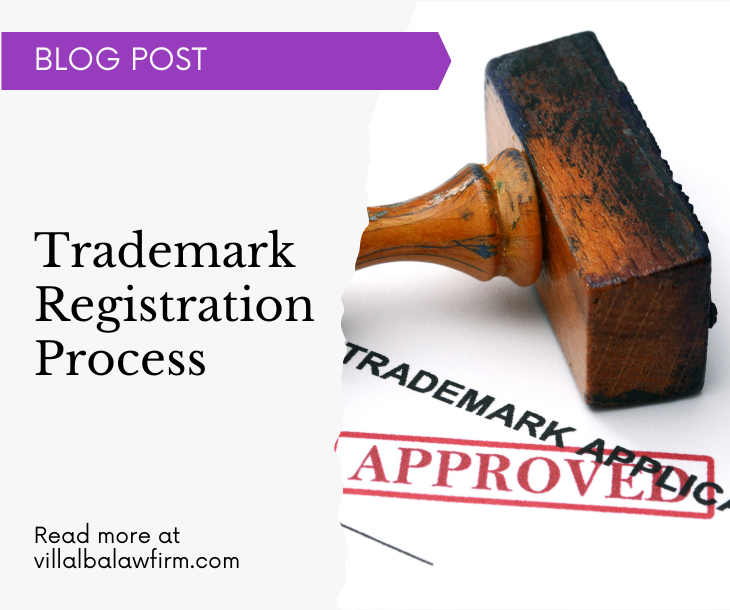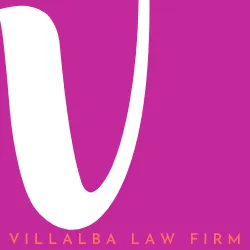You're Passionate About your Business.
That's why You Need Us to Protect It.
Villalba Law Firm Blog

Our blog is dedicated to expanding your legal mindset and empowering you with valuable information. We believe that by sharing insights and knowledge about legal strategies, we can help you navigate complexities, make informed decisions, and ultimately, unlock new opportunities for growth and success in your endeavors. Whether you're an entrepreneur, business owner, or individual seeking to understand the legal landscape better, our goal is to provide practical advice and resources that empower you to thrive in today's ever-evolving world.

Trademark Registration Process
“An image is not simply a trademark, a design, a slogan, or an easily remembered picture. It is a studiously crafted personality profile of an individual, institution, corporation, product or service.” - Daniel J. Boorstin
Demystifying the Trademark Registration Process
Many times I have clients come to me who want to register their marks, but are unsure of the process of the registration. Sometimes they've gone to the USPTO or secretary of state website and see the application and think that's all that it entails. Applying for registration of a trademark is much, much more than just filling out a piece of paper. The trademark application process is extremely complex; having an attorney to navigate it ensures proper guidance and increases your chances of success. We offer a variety of trademark application services to help you with this monumental decision.

**A trademark registration gives you a legal monopoly for the use of that mark in conjunction with specific goods or services. Registration is not an across the board monopoly to prevent others from using that mark. The same marks may be registered for different goods or services, like Delta for airlines and Delta for faucets.
Initial search
Ideally, before you even begin using a trademark/servicemark, you should conduct a search to discover any other marks that are out there that may be the same or similar to yours used along with your goods or services. The first search you can conduct is what we call a "knockout search," which consists of doing an initial search on your state trademark database and the USPTO database. This is just an initial search that covers the wording of a mark, and not necessarily any design elements. However, conducting a knockout search for trademarks is crucial to avoid potential conflicts and/or legal issues by identifying currently registered or pending registrations that may prevent your mark from obtaining registration, or worse, trademark infringement.
Comprehensive search
We conduct a comprehensive search by investigating not only registrations that are the same, but also similar to your mark, even in classes that may be ancillary that could cause a potential block to registration. Comprehensive searches include searching the USPTO database, state registrations, domain names, social profiles, websites and across the internet use of the mark in various iterations. The comprehensive search is then analyzed by the attorney to determine the risk level of filing the application and seeing it through to registration. Following the risk analysis, an opinion letter is drafted that shares the results and the attorney's risk assessment. By thoroughly assessing existing trademarks, you can protect your brand's integrity and ensure a smooth trademark registration process.
State trademark registration process
If you're looking at registration for a specific geographic area, then you will want to consider state trademark registration. Every state has its own process and application, and you should still conduct a search prior to filing the application.
Federal trademark registration process through the United States Patent and Trademark Office (USPTO)
The federal registration process is complex, requiring several steps, as well as a requirement of the mark actually being used in commerce. There are two types of applications: an in-use application for marks already in use, and intent-to-use application for marks that will be used at a later date, but an application is filed to reserve the mark. Intent-to-use applications will go through the same process with an additional step to provide a statement of use and evidence of use of the mark in the marketplace to convert the application to an in-use application.
Here is an overview of the process:
1. Identify classes
We assist you in determining the classes for your goods/services so we can conduct our knockout search, comprehensive search, and opinion letter. Trademarks are organized into various classes to separate them out for specific goods or services. For example, online educational courses fall into Class 41, whereas textbooks fall into Class 16.
2. Provide specimens
You will need to provide specimens of your mark in use in conjunction with your goods/services if you're filing an in-use application initially, or are converting an intent-to-use application to an in-use application. Specimens are evidence of use of the mark in the marketplace (what consumers see), such as a website, marketing materials, merchandise labels, or packaging.
3. File application
After obtaining the required information and specimens, we file the application for you. Following the filing, the USPTO will log the application into its database.
4. Assignment of application to examining attorney
Following a waiting period that is typically 6-9 months, the application is assigned to an examining attorney. The examining attorney will conduct her/his own search of the database. The results from this search may either be clearing the mark for publication, or issuing an Office Action. Office Actions require a response from us as your attorney of record, and can be for a variety of reasons such as requiring a disclaimer, or substitute specimen (non-substantive), or for likelihood of confusion, or descriptiveness (substantive). Substantive responses require a significant amount of legal research and drafting of arguments in support of registration. If a response is not filed, then your application will be abandoned.
5. Publication
Once the examining attorney approves the publication, the mark will be published in the Official Gazette. Trademarks are published in the Official Gazette to provide public notice and allow interested parties to oppose the registration if they believe it may cause confusion with their own trademarks. Interested parties have 30 days to file an opposition. If an opposition is filed against a trademark application, the matter is reviewed by the Trademark Trial and Appeal Board (TTAB), which decides whether to uphold or reject the opposition based on the merits of the case. If an opposition is not filed, then the mark will proceed to registration.
6. Registration and maintenance
If the mark proceeds to the registration process, a certificate will be sent to you as the trademark owner. You have a duty to monitor and police your mark from potential infringers. Additionally, at the 5 year and 10 year anniversaries, you must file a declaration of use of the mark in commerce to maintain your registration. After you use your mark for 5 years, your mark then becomes incontestable, meaning no one can petition to cancel your mark. It is your responsibility to continue to use the mark in the manner of your registration, as trademark protection can last in perpetuity.
Navigating the trademark registration process is a crucial step to protect your brand identity and intellectual property rights. By understanding the process, conducting thorough trademark searches, and working with experienced attorneys like us, you can gain valuable legal protection to secure your mark. There are many benefits of trademark registration, including exclusive rights to use the mark, enhanced brand recognition, and the ability to enforce trademark rights against infringers. Investing time and resources into trademark registration is an investment in the long-term success and reputation of your business.
Sign up to work with us to file your trademark application!
1329 E Kemper Rd. Suite 4100C
Cincinnati, OH 45245

serving clients virtually nationally and internationally
Licensed in Ohio
© 2024 Villalba Law Firm
This website doesn't give financial or legal advice. The stuff you see here, like text, images, and videos, is just for learning purposes. It's not a replacement for professional advice. We can't guarantee the info is accurate, so use the website at your own risk. Using our website also doesn't create an attorney-client relationship.



